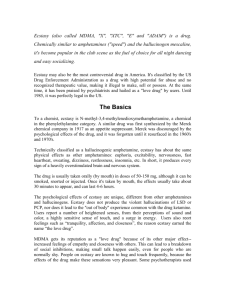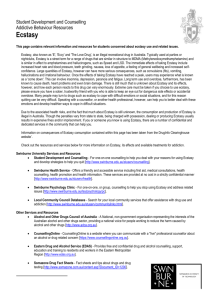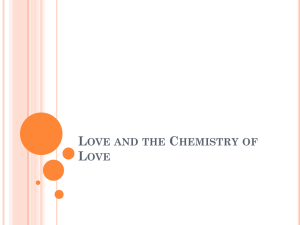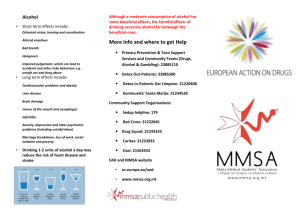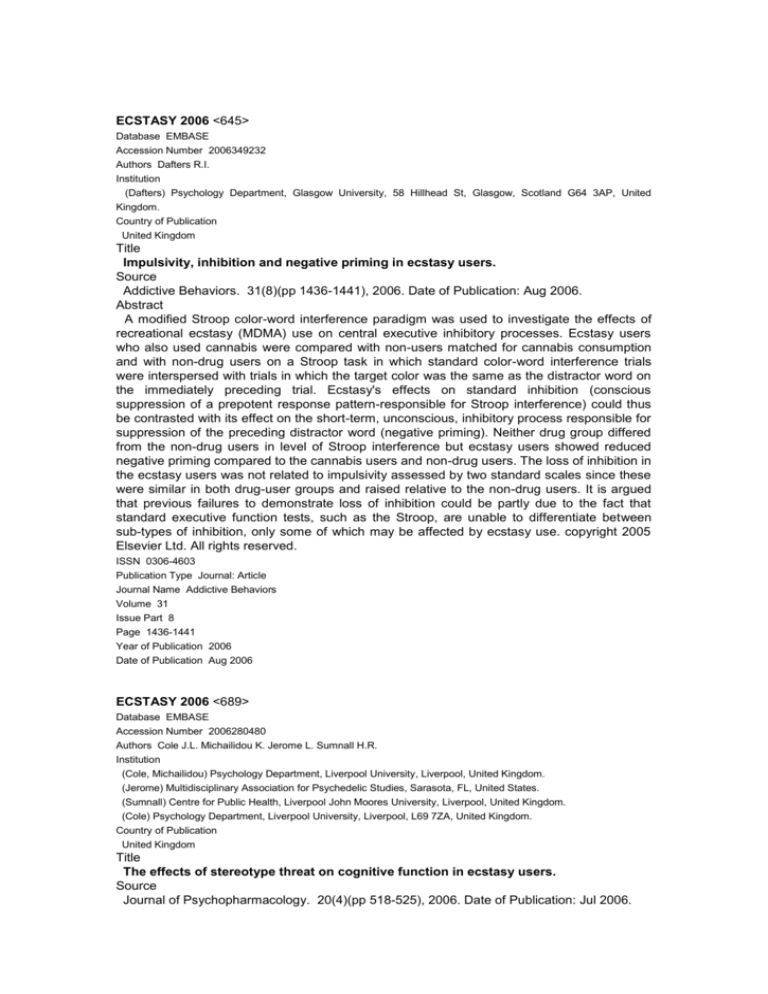
ECSTASY 2006 <645>
Database EMBASE
Accession Number 2006349232
Authors Dafters R.I.
Institution
(Dafters) Psychology Department, Glasgow University, 58 Hillhead St, Glasgow, Scotland G64 3AP, United
Kingdom.
Country of Publication
United Kingdom
Title
Impulsivity, inhibition and negative priming in ecstasy users.
Source
Addictive Behaviors. 31(8)(pp 1436-1441), 2006. Date of Publication: Aug 2006.
Abstract
A modified Stroop color-word interference paradigm was used to investigate the effects of
recreational ecstasy (MDMA) use on central executive inhibitory processes. Ecstasy users
who also used cannabis were compared with non-users matched for cannabis consumption
and with non-drug users on a Stroop task in which standard color-word interference trials
were interspersed with trials in which the target color was the same as the distractor word on
the immediately preceding trial. Ecstasy's effects on standard inhibition (conscious
suppression of a prepotent response pattern-responsible for Stroop interference) could thus
be contrasted with its effect on the short-term, unconscious, inhibitory process responsible for
suppression of the preceding distractor word (negative priming). Neither drug group differed
from the non-drug users in level of Stroop interference but ecstasy users showed reduced
negative priming compared to the cannabis users and non-drug users. The loss of inhibition in
the ecstasy users was not related to impulsivity assessed by two standard scales since these
were similar in both drug-user groups and raised relative to the non-drug users. It is argued
that previous failures to demonstrate loss of inhibition could be partly due to the fact that
standard executive function tests, such as the Stroop, are unable to differentiate between
sub-types of inhibition, only some of which may be affected by ecstasy use. copyright 2005
Elsevier Ltd. All rights reserved.
ISSN 0306-4603
Publication Type Journal: Article
Journal Name Addictive Behaviors
Volume 31
Issue Part 8
Page 1436-1441
Year of Publication 2006
Date of Publication Aug 2006
ECSTASY 2006 <689>
Database EMBASE
Accession Number 2006280480
Authors Cole J.L. Michailidou K. Jerome L. Sumnall H.R.
Institution
(Cole, Michailidou) Psychology Department, Liverpool University, Liverpool, United Kingdom.
(Jerome) Multidisciplinary Association for Psychedelic Studies, Sarasota, FL, United States.
(Sumnall) Centre for Public Health, Liverpool John Moores University, Liverpool, United Kingdom.
(Cole) Psychology Department, Liverpool University, Liverpool, L69 7ZA, United Kingdom.
Country of Publication
United Kingdom
Title
The effects of stereotype threat on cognitive function in ecstasy users.
Source
Journal of Psychopharmacology. 20(4)(pp 518-525), 2006. Date of Publication: Jul 2006.
Abstract
Stereotype threat occurs when individuals, believed to be intellectually inferior, perform
badly on cognitive tests they perceive to confirm stereotypes about them. Due to the wide
media coverage of studies purporting to show cognitive deficits in ecstasy users it is possible
that they experience stereotype threat. This study tested ecstasy and non-ecstasy using
polysubstance misusers on a variety of cognitive tests after they had been exposed to
stereotype threat. This priming consisted of exposing them to information about the long-term
effects of ecstasy which either stated that ecstasy caused memory loss or that it did not.
Ecstasy users that had been primed that ecstasy did not cause cognitive deficits performed
better than the other three groups on the delayed portion of the prose recall task from the
Rivermead Behavioural Memory Test battery. There were no other statistically significant
differences between any of the groups on any of the other cognitive tests used. This suggests
that stereotype threat exists in ecstasy users and may be influencing their performance in
experiments designed to identify cognitive deficits. In order to prevent this occurring in future
studies, experimenters must be careful how they conduct their experiments and discuss their
results with the media. copyright 2006 British Association for Psychopharmacology.
ISSN 0269-8811
Publication Type Journal: Article
Journal Name Journal of Psychopharmacology
Volume 20
Issue Part 4
Page 518-525
Year of Publication 2006
Date of Publication Jul 2006
ECSTASY 2006 <705>
Database EMBASE
Accession Number 2006271440
Authors Baylen C.A. Rosenberg H.
Institution
(Baylen, Rosenberg) Bowling Green State University, Department of Psychology, Bowling Green, OH, United
States.
(Baylen) Department of Psychology, Bowling Green State University, Bowling Green, OH 43403, United States.
Country of Publication
United Kingdom
Title
A review of the acute subjective effects of MDMA/ecstasy.
Source
Addiction. 101(7)(pp 933-947), 2006. Date of Publication: Jul 2006.
Abstract
Aim: Although several relatively recent reviews have summarized the neuropsychiatric
effects associated with chronic ecstasy use, there is no published comprehensive review of
studies on the acute subjective effects (ASEs) of MDMA/ecstasy. Design: The present study
reviewed the prevalence, intensity and duration of ASEs collected from 24 studies that
provided frequency data on the prevalence of self-reported ecstasy effects and/or provided
data on the intensity of ecstasy effects. Findings: Although hundreds of ASEs have been
reported following MDMA consumption, we identified a subset of effects reported repeatedly
by meaningful proportions and large numbers of participants across multiple investigations,
most of which were either emotional (e.g. anxiety, depression, closeness, fear, euphoria,
calmness) or somatic (e.g. nausea/vomiting, bruxism, muscle aches/headache, sweating,
numbness, body temperature changes, fatigue, dizziness, dry mouth, increased energy). Only
one sexual ASE (sexual arousal/increased sensual awareness), one cognitive ASE (confused
thought), one sensory-perceptual ASE (visual effects/changes in visual perception), one
sleep-related ASE (sleeplessness) and one appetite-related ASE (decreased appetite) were
reported across five or more investigations. Three factors - number of hours between
ingestion and assessment, dose level, and gender - have been associated with the acute
subjective experience of MDMA/ecstasy. Conclusions: This review provides useful
information for clinicians and researchers who want to understand the desirable and
undesirable ASEs that may motivate and restrain ecstasy use, for public health advocates
who seek to reduce biomedical harms (e.g. fainting, dehydration, shortness of breath,
bruxism) associated with recreational use of MDMA/ecstasy, and for educators who wish to
design credible prevention messages that neither underestimate nor exaggerate users'
experiences of this drug. copyright 2006 Society for the Study of Addiction.
ISSN 0965-2140
Publication Type Journal: Review
Journal Name Addiction
Volume 101
Issue Part 7
Page 933-947
Year of Publication 2006
Date of Publication Jul 2006
ECSTASY 2006 <820>
Database EMBASE
Accession Number 2006145577
Authors Wu Z.H. Holzer III C.E. Breitkopf C.R. Grady J.J. Berenson A.B.
Institution
(Wu, Breitkopf, Berenson) Department of Obstetrics and Gynecology, University of Texas Medical Branch, 301
University Blvd., Galveston, TX 77555-0587, United States.
(Holzer III) Department of Psychiatry and Behavioral Sciences, University of Texas Medical Branch, Galveston, TX,
United States.
(Grady) Office of Biostatistics, University of Texas Medical Branch, Galveston, TX, United States.
Country of Publication
United Kingdom
Title
Patterns and perceptions of ecstasy use among young, low-income women.
Source
Addictive Behaviors. 31(4)(pp 676-685), 2006. Date of Publication: Apr 2006.
Abstract
A significant number of young, low-income women experiment with ecstasy outside of club
or rave settings. The current study examined patterns and risk factors of ecstasy use among
this group of women. A cross-sectional survey was conducted among 696 women aged 18 to
31 who sought gynecological care from two university clinics in southeast Texas between
December 1, 2001, and May 30, 2003. Fifteen percent of participants reported ever using
ecstasy. Of those, over 90% used it at a friend's home. Compared with women who used only
marijuana or other illicit drugs, ecstasy users were more likely to be white, use a larger
number of other drugs, be willing to use drugs in the future, and have more friends who used
drugs. Fewer ecstasy users strongly disapproved of adult drug use than users of other illicit
drugs. Future interventional efforts should target young, low-income women to prevent future
experimentation with illicit drugs. copyright 2005 Elsevier Ltd. All rights reserved.
ISSN 0306-4603
Publication Type Journal: Article
Journal Name Addictive Behaviors
Volume 31
Issue Part 4
Page 676-685
Year of Publication 2006
Date of Publication Apr 2006
ECSTASY 2006 <962>
Database EMBASE
Accession Number 2006010790
Authors Di Benedetto M. D'Addario C. Candeletti S. Romualdi P.
Institution
(Di Benedetto, D'Addario, Candeletti, Romualdi) Department of Pharmacology, University of Bologna, Irnerio 48,
40126 Bologna, Italy.
Country of Publication
United Kingdom
Title
Chronic and acute effects of 3,4-methylenedioxy-N-methylamphetamine ('Ecstasy')
administration on the dynorphinergic system in the rat brain.
Source
Neuroscience. 137(1)(pp 187-196), 2006. Date of Publication: 2006.
Abstract
The prodynorphin system is implicated in the neurochemical mechanism of
psychostimulants. Exposure to different drugs of abuse can induce neuroadaptations in the
brain and affect opioid gene expression. The present study aims to examine the possibility of
a common neurobiological substrate in drug addiction processes. We studied the effects of
single and repeated 3,4-methylenedioxy-N-methylamphetamine ('Ecstasy') on the gene
expression of the opioid precursor prodynorphin, and on the levels of peptide dynorphin A in
the rat brain. Acute (8mg/kg, intraperitoneally) 3,4-methylenedioxy-N- methylamphetamine
markedly raised, two hours later, prodynorphin mRNA levels in the prefrontal cortex, and in
the caudate putamen, whereas it decreased gene expression in the ventral tegmental area.
Chronic (8mg/kg, intraperitoneally, twice a day for 7 days) 3,4-methylenedioxy-Nmethylamphetamine increased prodynorphin mRNA in the nucleus accumbens,
hypothalamus and caudate putamen and decreased it in the ventral tegmental area.
Dynorphin A levels increased after chronic treatment in the ventral tegmental area and
decreased after acute treatment in the nucleus accumbens, prefrontal cortex and
hypothalamus. These findings confirm the role of the dynorphinergic system in mediating the
effects of drugs of abuse, such as 3,4-methylenedioxy-N-methylamphetamine, in various
regions of the rat brain, which may be important sites for the opioidergic mechanisms
activated by addictive drugs. copyright 2005 Published by Elsevier Ltd on behalf of IBRO.
ISSN 0306-4522
Publication Type Journal: Article
Journal Name Neuroscience
Volume 137
Issue Part 1
Page 187-196
Year of Publication 2006
Date of Publication 2006

